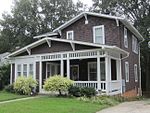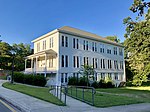William Thomas O'Brien House

William Thomas O'Brien House is a historic home in Durham, Durham County, North Carolina. It was built about 1890, and is a two-story, Gothic Revival style frame dwelling. It has a center hall plan and features a one-story wraparound porch, an original embossed tin shingle roof, and projecting bays. It was the home of William Thomas O'Brien, who perfected the Bonsack machine for the W. Duke Sons & Company. The house originally sat on a large tract of land that extended to Rome Street. The property included a servants' house, a smokehouse, and a chicken coop.The house, located down the street from Immaculate Conception Catholic Church and Immaculata Catholic School, played a significant role in Durham's Catholic community. O'Brien, who was Catholic, invited a priest to perform masses in the home until Immaculate Conception was constructed in 1906 on West Chapel Hill Street, on land that O'Brien deeded to the Church. After O'Brien's death in 1907, his wife moved to South Duke Street. In 1919, a carpenter and interior decorator named Edward J. Long lived in the house.Located in the Burch Avenue Historic District, it was listed on the National Register of Historic Places in 1985.
Excerpt from the Wikipedia article William Thomas O'Brien House (License: CC BY-SA 3.0, Authors, Images).William Thomas O'Brien House
Durham Freeway, Durham
Geographical coordinates (GPS) Address Nearby Places Show on map
Geographical coordinates (GPS)
| Latitude | Longitude |
|---|---|
| N 36.001666666667 ° | E -78.915277777778 ° |
Address
Smith Warehouse Parking Lot South
Durham Freeway
27708 Durham
North Carolina, United States
Open on Google Maps










